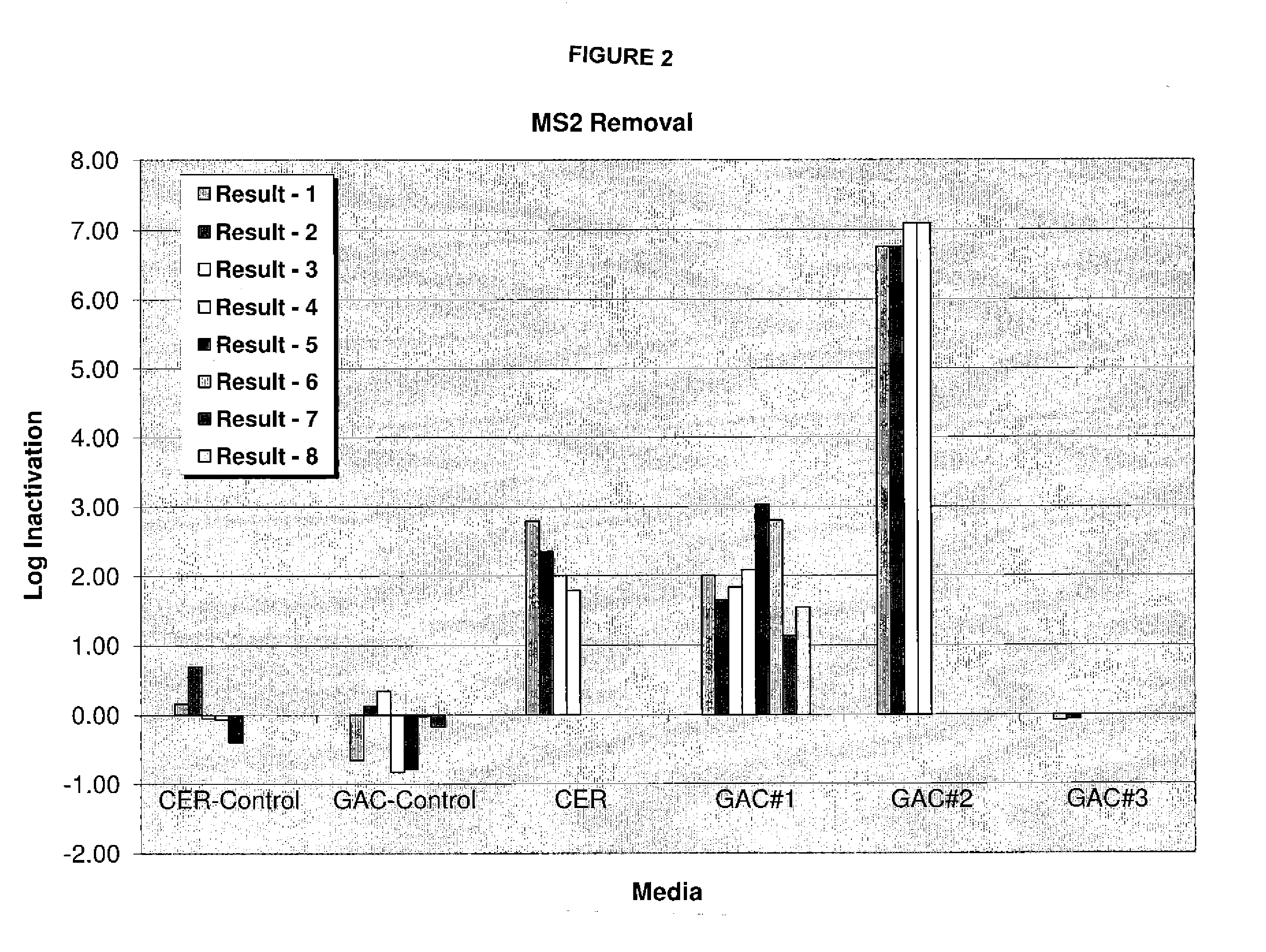Filtration media coated with zero-valent metals, their process of making, and use
a technology of zero-valent metals and filtration media, applied in the field of filtration media for treating fluids, can solve the problems of difficult control of cryptosporidiosis, death in the more sensitive subpopulation, and the insufficient effectiveness of classical disinfectants, such as chlorine, to prevent the spread of viruses and protozoa
- Summary
- Abstract
- Description
- Claims
- Application Information
AI Technical Summary
Problems solved by technology
Method used
Image
Examples
example 1
[0111]Filter media were prepared by incorporating NSZVI into two filter media, granular activated carbon (GAC) and cation exchange resin (CER), for drinking water applications. These NSZVI enhanced media were characterized. The NSZVI based media demonstrated their superior performance with respect to the removal of microbial agents, chemical contaminants, and disinfectant from drinking water.
[0112]While iron was used as an exemplary metal, other metals such as aluminum can also be used. Two reduction methods were used to form the filter media, high temperature (dry) reduction and aqueous chemical (wet) reduction, for coating NSZVI onto GAC and CER. Both methods involve deposition of ferric ion, Fe(III), onto a medium surface followed by dry (with hydrogen) or wet reduction (with sodium borohydride) of Fe(III) to NSZVI. Coating of GAC using both methods was used, whereas coating of CER by wet reduction only was used because CER is labile at high temperatures (max. temp.=121° C.). We ...
example 2
[0136]The disinfection effectiveness of the NSZVI coated GAC and CER media on microorganisms was measured.
[0137]MS2 and T1, which are both bacteriophage or bacterial viruses, are both F-specific RNA bacteriophage and their structure resembles many human enteric viruses and have been used as surrogates for human enteric viruses. MS2 (ATCC 15597-B1) was grown and assayed using E. coli (ATCC23631) as the host organism. T1 (ATTCC-11303 B) was assayed with E. coli CN13 (ATCC 700609) as the host. The methodology for growth, detection and enumeration of F-specific RNA bacteriophage was based on ISO Method 10705 (ISO, 1995) and Appendix A of the US EPA Ultraviolet Disinfection Guidance Manual (November, 2006).
[0138]Additional experiments were conducted using fecal coliform and pure culture E. coli. The assay for fecal coliform followed the HydroQual Standard Operation Protocol (SOP) #33 (certified by the State of New Jersey). A known volume of water sample was filtered through a 0.45 μm por...
example 3
[0142]The removal of chemicals contaminants from water by the NSZVI coated GAC and CER media was measured.
[0143]Solutions of chemical contaminants were prepared in uniform concentrations using distilled water. The compounds were PbCl2 (99% purity), bromodichloroacetate (99% purity) and NaOCl (5% chlorine). All of the filter media coated with NSZVI in Example 1 were tested using the same test procedure as in Example 2. Samples for chlorine removal were analyzed immediately after the test at HydrorQual's lab using a chlorine meter (HACH, model CN-80) with HACHDPD total chlorine reagent. Quantification of lead was performed by Columbia “Analytical Services (CAS) using EPA Method 6010B (Inductively Coupled Plasma-Atomic Emission Spectrometry). Quantification of bromodichloroacetic acid was performed by CAS using EPA Method 552.2 FIGS. 5-7 show the removal of these chemical contaminates by the NXZVI coated GAC and CER media in comparison to the controls of uncoated GAC and CER. In genera...
PUM
| Property | Measurement | Unit |
|---|---|---|
| size | aaaaa | aaaaa |
| linear velocity | aaaaa | aaaaa |
| residence time | aaaaa | aaaaa |
Abstract
Description
Claims
Application Information
 Login to View More
Login to View More - R&D
- Intellectual Property
- Life Sciences
- Materials
- Tech Scout
- Unparalleled Data Quality
- Higher Quality Content
- 60% Fewer Hallucinations
Browse by: Latest US Patents, China's latest patents, Technical Efficacy Thesaurus, Application Domain, Technology Topic, Popular Technical Reports.
© 2025 PatSnap. All rights reserved.Legal|Privacy policy|Modern Slavery Act Transparency Statement|Sitemap|About US| Contact US: help@patsnap.com



